Solved GATE Questions on Flow through pipes
Data for Q. 1-2 are given below. Solve the problems and choose correct answers.
A syringe with a frictionless plunger contacts water and has its end 100 mm longer needle of 1mm diameter. The internal diameter of the syringe is 10 mm. Water density is 1000  . The plunger is pushed out at 10 mm/s and the water comes out as a jet
. The plunger is pushed out at 10 mm/s and the water comes out as a jet

Question 1. Assuming ideal flow, the force F in Newton required on the plunger to push out the water is
(A) 0
(B) 0.04
(C) 0.13
(D) 1.15
GATE-ME-2003
Hint 1. (Ans B)

Velocity at point 1=velocity of plunger=10 mm/s=0.01 m/s

Applying Bernoulli’s Equation at point 1and 2, we have,
![]()
![]()
Since ![]()
![]()
![]()

Applying continuity equation at points (i) and (ii), we have
![]()
![]()
![]()
![]()
![]() Now from equation (i),
Now from equation (i),
![]()
![]()
![]()
Force required on plunger
![]()
![]()
Question 2. Neglect losses in the cylinder and assume fully developed laminar viscous flow throughout the needle; the Darcy friction factor is  . Where
. Where  is the Reynolds number. Given that the viscosity of water is 1.0
is the Reynolds number. Given that the viscosity of water is 1.0 , the force F in Newton required on the plunger is
, the force F in Newton required on the plunger is
(A) 0.13
(B) 0.16
(C) 0.3
(D) 4.4
GATE-ME-2003
Hint 2. (Ans C)
Given, v=velocity of water =
Now
![]()
![]()
![]()
![]()
Now Darcy’s friction factor,
![]()
Head loss in needle=
![]()
![]()
![]()
Applying Bernoulli’s equation at points 1 and 2, we have
![]()
Since ![]()
![]()
![]()
![]()
![]()
Now force required on plunger
![]()
![]()
![]()
Question 3. For a fluid flow through a divergent pipe of length L having inlet and outlet radii of  respectively and a constant flow of Q assuming the velocity to be axial and uniform at any cross section, the acceleration at exit is
respectively and a constant flow of Q assuming the velocity to be axial and uniform at any cross section, the acceleration at exit is
(A) ![]()
(B) ![]()
(C) ![]()
(D) ![]()
GATE-ME-2004
Hint 3. (Ans C)
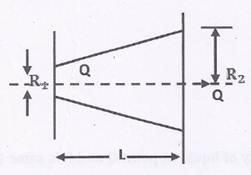
Velocity at inlet, 
Velocity at outlet , 
Acceleration 

Acceleration at the exit



Considering limiting case, i.e.  , we have
, we have
Acceleration at the exit


Question 4. A siphon draws water from a reservoir and discharges it out at atmospheric pressure. Assuming ideal fluid and the reservoir is large, the velocity at point P in the siphon tube is :

(A) ![]()
(B) ![]()
(C) ![]()
(D) ![]()
GATE-ME-2006
Hint 4. (Ans C)
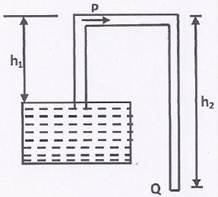
By energy conservation, velocity at point

As there is a continuous and uniform flow, so velocity of liquid at point Q and P is same (i.e.  )
)
i.e., kinetic energy of water =Potential energy





Question 5. The velocity profile in fully developed laminar flow in a pipe of diameter D is given by  , where r is the radial distance from the centre. If the viscosity of the fluid is
, where r is the radial distance from the centre. If the viscosity of the fluid is  , the pressure drop across a length L of the pipe is :
, the pressure drop across a length L of the pipe is :
(A) ![]()
(B) ![]()
(C) ![]()
(D) ![]()
GATE-ME-2006
Hint 5. (Ans D)
By Hagen –Poiseuille law, for steady laminar flow in circular pipes
Newton’s law of viscosity across section.

Shear stress across section varies with ‘r’ as 

For fully developed laminar flow







Linked Answer Question Q.6 –Q.7 Carry two marks Each.
Consider a steady incompressible flow through a channel as shown below.
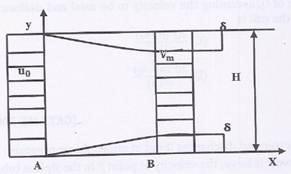
The velocity profile is uniform with a value of ![]() at the inlet section A. The velocity profile at section B downstream is
at the inlet section A. The velocity profile at section B downstream is

Question 6. The ratio  is
is
(A) ![]()
(B) 1
(C) ![]()
(D) ![]()
GATE-ME-2007
Hint 6. (Ans A)
Assume width of channel is b. Applying continuity equation at A and B.
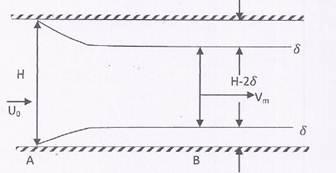


Question 7. The ratio  (where
(where  are the pressure at section A and B, respectively, and
are the pressure at section A and B, respectively, and  is the density of the fluid) is
is the density of the fluid) is
(A) 
(B) ![]()
(C) ![]()
(D) ![]()
GATE-ME-2007
Hint 7. (Ans C)
Applying Bernoulli’s equation at A and B




Using the value of  from the first part of the question, we get,
from the first part of the question, we get,

Question 8. Consider steady state laminar incompressible axi-symmetric fully developed viscous flow through a straight circular pipe of constant cross-sectional area at a Reynolds number of 5. The ratio of inertia force to viscous force on a fluid particle is
(A) 5
(B) 1/5
(C) 0
(D) 
GATE-ME-2007
Hint 8. (Ans A)
![]()
Question 9. The velocity profile of a fully developed laminar flow in a straight circular pipe, as shown in the figure, is given by the expression  where
where  is a constant. The average velocity of fluid in the pipe is
is a constant. The average velocity of fluid in the pipe is
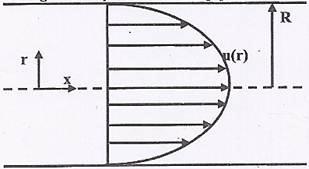
(A) ![]()
(B) ![]()
(C) ![]()
(D) ![]()
GATE-ME-2009
Hint 9. (Ans A)




Solving, we get

Now Q=Area x average velocity


Question 10. Water at 25 is flowing through a 1.0 km long G.I pipe of 200 mm diameter at the rate of 0.07
is flowing through a 1.0 km long G.I pipe of 200 mm diameter at the rate of 0.07  . If the value of Darcy friction factor for this pipe is 0.02 and density of water is 1000 kg/
. If the value of Darcy friction factor for this pipe is 0.02 and density of water is 1000 kg/ , the pumping power (in KW) required to maintain the flow is
, the pumping power (in KW) required to maintain the flow is
(A) 1.8
(B) 17.4
(C) 20.5
(D) 41.0
GATE-ME-2009
Hint 10. (Ans B)





Question 11. The maximum velocity of a one-dimensional incompressible fully developed viscous flow, between two fixed parallel plates, is 6 m/s. the mean velocity (in m/s) of the flow is
(A) 2
(B) 3
(C) 4
(D) 5
GATE-ME-2010
Hint 11. (Ans C)



Question 12. For steady, fully developed flow inside a straight pipe of diameter D, neglecting gravity effects, the pressure drop  over a length L and the wall shear stress
over a length L and the wall shear stress  are related by
are related by
(A) ![]()
(B)![]()
(C) ![]()
(D) ![]()
GATE-ME-2013
Hint 12. (Ans C)



Answer keys
1. (B) 2. (C) 3. (C) 4. (C) 5. (D) 6. (A) 7. (C) 8.(A) 9. (A) 10. (B) 11. (C) 12. (A)
One Response to “Previous Years GATE Questions on Flow through pipes”
Mayand Malik
Above Linked Questions Q-6 &7 are wrongly answered. Please do correct these answers.